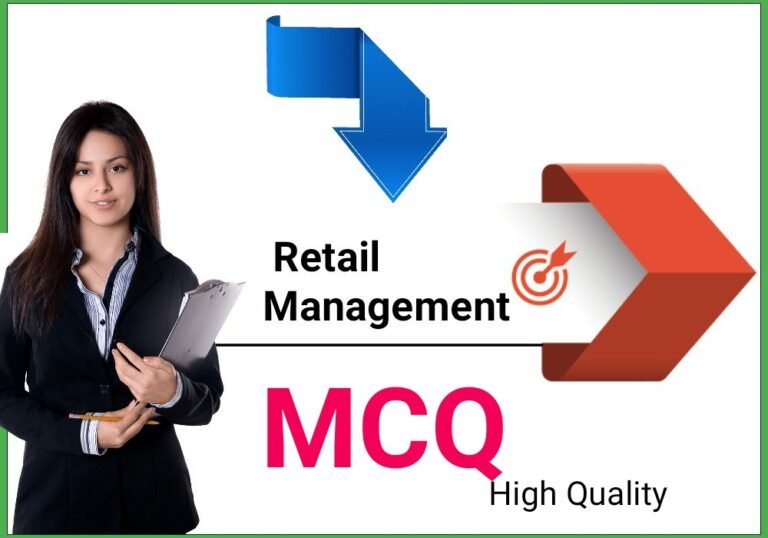Retail management mcq with answers. Retail Management MCQ Questions and Answers pdf – MCQ on Retail Management for the preparation of academic and competitive exams.

Retail Management MCQ Questions and Answers
1. The first and foremost method of retail is:
a. Counter service
b. Self-service
c. Online shops
d. Cost-plus pricing
Answer: (A)
2. In a ___, a retailer sells to consumers through multiple retail formats, such as websites, physical stores.
a. Multi-channel retailing
b. Retail management
c. Counter selling
d. Retail strategy
Answer: (A)
3. Retail business generates an enormous amount of information that would be very valuable if one could:
a. Collect it quickly, reliably, and efficiently
b. Analyze it to make sense of the past and plan future decisions
c. Distribute it to the right people in your organization so they can act on it
d. All of the above
Answer: (D)
4. Small grocery stores that are run by individuals or families and cater to their immediate neighborhood or locality.
a. Brick and mortar stores
b. Mom-and-pop stores
c. Departmental stores
d. Kirana stores
Answer: (B)
5. The planning system prioritizes according to ___ since that is the best way to ensure the lowest possible inventory.
a. Packaging date
b. Delivery date
c. Shipment date
d. Distribution date
Answer: (C)
6. ___ represent anticipated demand.
a. Forecast
b. Blanket order
c. Both a and b
d. None of the above
Answer: (C)
7. A ___ can be regarded as an item at a specific location.
a. SBU
b. SKU
c. Order tracking
d. Multi-location
Answer: (B)
8. The ___, despite its name, acts more like a sub-location than just a shelf in a warehouse.
a. Bar code
b. Bin code
c. Zip code
d. Pin code
Answer: (B)
9. The planning system controls that by running through the:
a. Inventory profile
b. Outer loop
c. Order quantity
d. Transfer order
Answer: (A)
10. Demand exists but there is no supply:
a. The planning has finished
b. Supply should be suggested
c. Supply should be canceled
d. No demand or supply exists
Answer: (B)
11. If the supply quantity is ___ than the demand, it is possible that the supply quantity could be decreased.
a. Increased
b. Decreased
c. More than
d. Less than
Answer: (C)
12. Rescheduling could be ruled out because:
a. The supply has already been tied up to another demand on a previous date
b. The rescheduling is so minimal that the user has defined it as negligible
c. The supply is linked directly to some other demand
d. Both a and b
Answer: (D)
13. A reorder point represents demand during
a. Peak time
b. Lead time
c. Season
d. None of the above
Answer: (B)
14. The planning system checks that the item carries a production forecast or a sales order.
a. MRP
b. MPS
c. SKU
d. SBU
Answer: (B)
15. It is a system of technologies and processes that senses and responds to real-time demand across a network of customers, suppliers, and employees.
a. Demand-driven Retailing
b. Supply chain management
c. Customer relationship management
d. Demand statistics
Answer: (A)
16. It stops junk e-mail in its tracks.
a. Firewall
b. Anti-spam
c. Anti-virus
d. All of the above
Answer: (B)
17. SAP implementation project was divided into ___ phases.
a. Two
b. One
c. Three
d. Double
Answer: (C)
18. Identify optimum business rules and leverage your corresponding business logic across your retail chain.
a. Enhance process control
b. Streamline systems management
c. Separate application code from business logic
d. Leverage powerful enterprise integration bus
Answer: (A)
19. The ability to exchange information electronically is central to the effective conduct of e-commerce.
a. E-mail
b. E-messaging
c. EAN
d. E-business
Answer: (B)
20. The Global Commerce Initiative (GCI) is a global user group, created in
a. 1998
b. 1987
c. 1999
d. 1983
Answer: (C)
21. ___ is defined as being the continuous and automated exchange of master data between trading partners.
a. Data synchronization
b. Data standardization
c. Data classification
d. Data rationale
Answer: (A)
22. The ___ is a global service for the registration and validation of items and provides global capability.
a. Global Commerce
b. Global registry
c. Global data interchange
d. Global integrity
Answer: (B)
23. Retailers are totally dependent on the GTNs to support their:
a. Ordering system
b. Stock management system
c. Point Of sale system
d. All of the above
Answer: (D)
24. The most costly element of the international comparison program (ICP) is the construction of:
a. Purchasing power parities
b. Point of Sale
c. EDIFACT
d. GTN
Answer: (A)
25. Build your business on a solid transactional backbone and integrate different sales channels, better understand customer preferences, and leverage customer information.
a. Supply chain execution
b. Multi-channel retailing
c. Purchasing
d. Category management
Answer: (B)
26. It is the near-unanimous choice of experienced ERP implementers as the most underestimated budget item.
a. Development
b. Training
c. Coaching
d. Mentoring
Answer: (B)
27. The ___ project addresses the area of e-logistic, focusing specifically on e-fulfillment.
a. e-Thematic
b. e-business
c. e-Commerce
d. None of the above
Answer: (A)
28. It refers, in a broad sense, to the conversion of activities and processes throughout an enterprise into an electronic-based system.
a. e-Thematic
b. e-business
c. e-Commerce
d. None of the above
Answer: (B)
29. ___ model allows for improved efficiencies throughout the supply chain and set up an order management system.
a. e- Business
b. e- commerce
c. e-Thematic
d. Both a and b
Answer: (A)
30. It refers to more than setting up an internet-enabled front office.
a. e-Thematic
b. e-business
c. e-Commerce
d. e-Fulfillment
Answer: (D)
31. It provides a set of computer tools to assist transport operators in planning their transport services.
a. MOSCA
b. IBOS
c. Parcel Call
d. Multi-modal
Answer: (A)
32. The possible future directions of ECG:
a. Extension to other modes of transport and/or to other logistics services.
b. Opening of the marketplace to other interested groups.
c. Investigating more sophisticated IT solutions.
d. All of the above
Answer: (D)
33. Facilitates the creation and execution of contracts and performance against those contracts.
a. e-Procurement
b. Contract Management
c. Business intelligence
d. E-Tour
Answer: (B)
34. It is a browser-based solution that delivers an intuitive, easy-to-use requisition system.
a. PROACTIS
b. INVESCO
c. IPOS
d. eREQUISITION
Answer: (C)
35. Sauflon saw the main benefits of e-Fulfillment as:
a. Increased data security
b. Increased speed to response time
c. Reduced (or no) transcription errors and
d. Reduced lead time
e. All of the above
Answer: (E)
36. The marketing and selling of goods or services using internet-based computing and communication.
a. e-Business
b. e-Commerce
c. e- Fulfillment
d. e- Thematic
Answer: (B)
37. The technical solution for accessing item-related information is:
a. Read ePC from e-tag
b. Get network address from ONS
c. Retrieve product information based on software agents that share information in a peer-to-peer fashion
d. All of the above
Answer: (D)
38. The ___ of installation of the software components is also important for rapid implementation in the logistics network.
a. Leanness
b. Simplicity
c. Both a and b
d. None of the above
Answer: (C)
39. ___ enforces privacy policy set by the policy engine.
a. Consumer agent
b. Tag authentication
c. RFID tags
d. Reader core
Answer: (A)
40. It refers to the system installed in a Retail Outlet, which substantially automates the Billing Process using the information on Products & Prices from the database.
a. TCO
b. POS
c. HP-POS
d. DOS
Answer: (B)
41. ___ is a group of substitutable products, and ___ is a group of commodities sharing a common use or function.
a. Family, class
b. Commodity, class
c. Business function, Commodity
d. Segment, class
Answer: (B)
42. The UNSPSC can be embedded in:
1. Resource planning
2. Purchasing
3. Accounting
4. Database
a. 1, 2, 3
b. 1, 2, 3, 4
c. 2, 3, 4
d. 1, 3, 4
Answer: (B)
43. The ___ and ___ is a symbology specifically designed for assisting the commercial activities of product awareness, discovery, and spend analysis.
a. UNSP and Service Code
b. UCC and EAN bar codes
c. UNSPSC and Service code
d. None of the above
Answer: (A)
44. The unused capacity in networks of PCs is usually ___ during the day and ___ outside it.
a. 98%, 95%
b. 85%, 100%
c. 76%, 29%
d. 86%, 34%
Answer: (B)
45. ___ suppliers will be able to walk customers through potential designs, more effectively than their current approaches.
a. Kitchen
b. Bedroom
c. Both a and b
d. Living room
Answer: (C)
46. A product or service is classified with others that serve or support:
a. Common function
b. Purpose
c. Task
d. All of the above
Answer: (D)
47. ___ is the identification of relevant suppliers of a specific product or service, while ___ reporting on the use of funds.
a. Product awareness, Resource discovery
b. Resource discovery, expenditure analysis
c. Product awareness, expenditure analysis
d. Both b and c
Answer: (B)
48. The combination of ___ and ___ can translate into real problems for business decision-makers at every level of a retail organization.
a. Challenges & constraints
b. Industry changes, Business challenges
c. Industry-wide challenges, technology constraints
d. All of the above
Answer: (C)
49. ___ needs to monitor and manage margins, shrinkage, and ___ who want to hit revenue targets and improve customer relations.
a. Department managers, Merchandising executives
b. Financial officers, Sales personnel
c. Business leaders, Merchandising executives
d. None of the above
Answer: (A)
50. Mobile access to warehouse processes for:
a. Stocking, Restocking
b. Discarding, returning
c. Distribution, substitution
d. Both a and b
Answer: (D)
51. The importance of retailing management includes the following:
a. Reducing consumer choices
b. Enhancing customer satisfaction
c. Decreasing competition
d. Increasing product prices
Answer: (B)
52. Introduction of retail management involves:
a. Exploring deep-sea ecosystems
b. Studying celestial bodies
c. Understanding consumer behavior and preferences
d. Analyzing geological formations
Answer: (C)
53. The factor leading to the growth of retailing is:
a. Decreased consumer spending
b. Limited product variety
c. Urbanization and rising income levels
d. Increased manufacturing costs
Answer: (C)
54. What is not easy to change in retail management?
a. Store location
b. Pricing strategy
c. Staff uniforms
d. Advertising slogans
Answer: (A)
55. What is retail management?
a. Managing large-scale industrial production
b. Selling goods in a wholesale market
c. Organizing retail events
d. The process of efficiently running retail operations
Answer: (D)
56. Which activity is not a part of retail sales?
a. Product Promotion
b. Inventory management
c. Pricing strategy
d. Product Manufacturing
Answer: (D)
MCQ on Inventory Management with answers
Conclusion Points
Thanks for visiting our website, if you like the post on Retail Management MCQ Questions and Answers please share it on social media. If you have any query related to Retail Management ask through below comment box.



